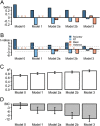The impact of evidence reliability on sensitivity and bias in decision confidence
- PMID: 28383959
- PMCID: PMC5524444
- DOI: 10.1037/xhp0000404
The impact of evidence reliability on sensitivity and bias in decision confidence
Abstract
Human observers effortlessly and accurately judge their probability of being correct in their decisions, suggesting that metacognitive evaluation is an integral part of decision making. It remains a challenge for most models of confidence, however, to explain how metacognitive judgments are formed and which internal signals influence them. While the decision-making literature has suggested that confidence is based on privileged access to the evidence that gives rise to the decision itself, other lines of research on confidence have commonly taken the view of a multicue model of confidence. The present study aims at manipulating one such cue: the perceived reliability of evidence supporting an initial decision. Participants made a categorical judgment of the average color of an array of eight colored shapes, for which we critically manipulated both the distance of the mean color from the category boundary (evidence strength) and the variability of colors across the eight shapes (evidence reliability). Our results indicate that evidence reliability has a stronger impact on confidence than evidence strength. Specifically, we found that evidence reliability affects metacognitive readout, the mapping from subjectively experienced certainty to expressed confidence, allowing participants to adequately adjust their confidence ratings to match changes in objective task performance across conditions. (PsycINFO Database Record
(c) 2017 APA, all rights reserved).
Figures




References
-
- Bang D., Fusaroli R., Tylén K., Olsen K., Latham P. E., Lau J. Y. F., et al. Bahrami B. (2014). Does interaction matter? Testing whether a confidence heuristic can replace interaction in collective decision-making. Consciousness and Cognition, 26, 13–23. 10.1016/j.concog.2014.02.002 - DOI - PMC - PubMed
MeSH terms
LinkOut - more resources
Full Text Sources
Other Literature Sources

